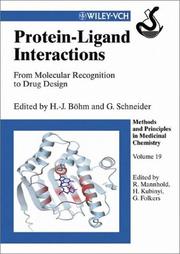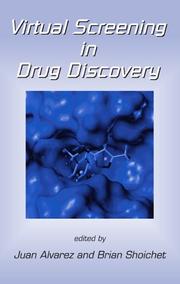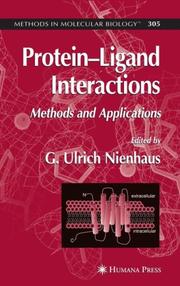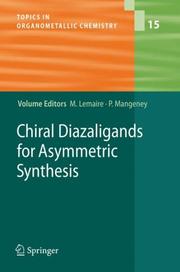| Listing 1 - 4 of 4 |
Sort by
|

ISBN: 3527305211 9783527305216 Year: 2005 Volume: 19 Publisher: Weinheim: Wiley,
Abstract | Keywords | Export | Availability | Bookmark
 Loading...
Loading...Choose an application
- Reference Manager
- EndNote
- RefWorks (Direct export to RefWorks)
Ligands. --- Protein Binding. --- Drug Design. --- Models, Molecular. --- Fãrmacos (química) --- Proteins. --- Ligand binding (Biochemistry) --- Protéines --- Ligands --- Ligands (Biochimie) --- Fixation --- Ligands (Biochemistry) --- Basic Sciences. Chemistry --- Biochemistry --- Ligand binding (Biochemistry). --- Ligands (Biochemistry). --- Biochemistry. --- Fármacos (química) --- Protéines --- Pharmacosynthesis. Pharmacochemistry --- Protein Binding --- DRUG DESIGN --- MODELS, MOLECULAR --- Chemistry of complexes --- fysicochemie --- Molecular biology --- Proteins

ISBN: 9780824754792 0824754794 Year: 2005 Publisher: Boca Raton : Taylor & Francis,
Abstract | Keywords | Export | Availability | Bookmark
 Loading...
Loading...Choose an application
- Reference Manager
- EndNote
- RefWorks (Direct export to RefWorks)
Drug Evaluation, Preclinical --- Computational Biology --- Molecular Biology --- Pharmaceutical Preparations --- Drug development --- Drugs --- Ligand binding (Biochemistry) --- Pharmaceutical chemistry --- Médicaments --- Ligands (Biochimie) --- Chimie pharmaceutique --- methods. --- analysis. --- Computer simulation. --- Structure-activity relationships --- Développement --- Simulation par ordinateur --- Relations structure-activité --- Fixation

ISSN: 10643745 ISBN: 1588293726 9786610359134 1280359137 1592599125 9781588293725 Year: 2005 Volume: 305 Publisher: Totowa, N.J.: Humana press,
Abstract | Keywords | Export | Availability | Bookmark
 Loading...
Loading...Choose an application
- Reference Manager
- EndNote
- RefWorks (Direct export to RefWorks)
Molecular recognition and binding of ligands (atoms, ions, and molecules) by proteins with high sensitivity and selectivity is of central importance to essentially all biomolecular processes and of key importance for the basic and applied sciences. In Protein-Ligand Interactions: Methods and Applications, leading experts with hands-on experience describe in detail a broad selection of established and emerging techniques for studying the interaction between proteins and ligands, including bulk biochemical techniques, structure analysis, spectroscopy, single-molecule studies, and theoretical/computational tools. Among the highlights are surface plasmon resonance (SPR) and reflectometric biosensor approaches, high-throughput screening with confocal optics microscopy, single molecule fluorescence and fluorescence correlation spectroscopy (FCS), atomic force microscopy (AFM), crystallography of reaction intermediates, and time-resolved X-ray crystallography. The protocols follow the successful Methods in Molecular Biology™ series format, each offering step-by-step laboratory instructions, an introduction outlining the principle behind the technique, lists of the necessary equipment and reagents, and tips on troubleshooting and avoiding known pitfalls. Cutting-edge and highly practical, Protein-Ligand Interactions: Methods and Applications offers novice and expert researchers alike a broad selection of powerful and widely applicable techniques that can be used to efficiently and successfully solve the task of characterizing protein-ligand interactions.
Protein binding --- Ligands --- Proteins --- Chemistry Techniques, Analytical --- Protein Binding --- chemistry --- methods --- Chemistry, Analytic -- Laboratory manuals. --- Protein binding -- Laboratory manuals. --- Laboratory Chemicals --- Specialty Uses of Chemicals --- Binding, Protein --- Chemistry, Analytic --- Biochemistry --- Allosteric proteins --- Radioligand assay --- Biochemistry. --- Biochemistry, general. --- Biological chemistry --- Chemical composition of organisms --- Organisms --- Physiological chemistry --- Biology --- Chemistry --- Medical sciences --- Composition --- Protein binding - Laboratory manuals --- Ligands - laboratory manuals --- Proteins - chemistry - Laboratory Manuals --- Chemistry Techniques, Analytical - methods - laboratory manuals --- Protein Binding - Laboratory Manuals

ISBN: 9783540260646 3540260641 3540314423 Year: 2005 Publisher: Berlin, Heidelberg : Springer Berlin Heidelberg : Imprint: Springer,
Abstract | Keywords | Export | Availability | Bookmark
 Loading...
Loading...Choose an application
- Reference Manager
- EndNote
- RefWorks (Direct export to RefWorks)
The use of phosphine derivatives has historically induced the tremendous development of catalysis (both non-asymmetric and asymmetric). Although the chemistry of amines is more documented, the use of nitrogen-containing ligands only appeared recently. Nevertheless, during the last ten years, the results describing chiral diamine preparations and their uses in asymmetric catalysis and synthesis are increasing faster than their phosphorus counterparts. The reader will find in this volume the most recent methods for the synthesis of chiral diamines as well as their applications in asymmetric catalysis of CC bond formation. Particular attention will be given to spartein and derivatives of such diamines. Recently, the particular properties and the chemistry of amines allowed to obtain catalysts easy to separate and recycle and new types of ligands such as diaminocarbenes, ureas and thioureas. Finally, the complexing properties of some diamines allowed the formation of complexes with chirality "at the metal " which is of major theoretical interest and presents numerous potential applications.
Asymmetric synthesis. --- Chirality. --- Ligands. --- Chiralité --- Ligands --- Chemistry. --- Chemistry, inorganic. --- Chemistry, Organic. --- Biochemistry. --- Catalysis. --- Organometallic Chemistry. --- Medicinal Chemistry. --- Inorganic Chemistry. --- Organic Chemistry --- Chemistry --- Physical Sciences & Mathematics --- Biological chemistry --- Chemical composition of organisms --- Organisms --- Physiological chemistry --- Organic chemistry --- Inorganic chemistry --- Composition --- Inorganic chemistry. --- Organometallic chemistry. --- Medicinal chemistry. --- Activation (Chemistry) --- Chemistry, Physical and theoretical --- Surface chemistry --- Inorganic compounds --- Biology --- Medical sciences --- Organometallic chemistry . --- Chemistry, Medical and pharmaceutical --- Chemistry, Pharmaceutical --- Drug chemistry --- Drugs --- Medical chemistry --- Medicinal chemistry --- Pharmacochemistry --- Chemistry, Organometallic --- Metallo-organic chemistry --- Chemistry, Organic --- Pharmaceutical chemistry. --- Chemistry, Inorganic.
| Listing 1 - 4 of 4 |
Sort by
|

 Search
Search Feedback
Feedback About UniCat
About UniCat  Help
Help News
News